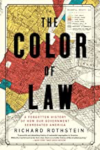The Color of Law: A Forgotten History of How Our Government Segregated America. By Richard Rothstein.
One interpretation of segregation goes like this: Blacks in the 20th century were treated as second-class citizens, but segregation was not because of the government. Rather, it was a consequence of private decisions: whites refusing to sell to blacks, pushing them out of neighborhoods, and so on. But fortunately the Fair Housing Act of 1968 ended private segregation so things should be better from here.
Rothstein demolishes that argument, of course. Step by step, he shows that government policies at all levels created and enforced segregation. He focuses on WWII era and the time after that, when government subsidizes housing, creates suburbs, and puts in highways, all the while discriminating. So instead of Blacks participating in the benefits of this, they are locked out. Fifty+ years later you can see the effects: the difference in equity value in homes translates into wealth differences.
Rothstein doesn’t quite have a solution for all this, but he notes that the government discriminated both implicitly and explicitly discrimination by government, actively and passively (failing to enforce laws). People have struggled to prove government discrimination because it’s been so pervasive (with a whole-system level to it). He doesn’t favor the term “reparations” but feels there must be remedies applied to address this history (not just payments but also policy changes to offset past wrongs).
